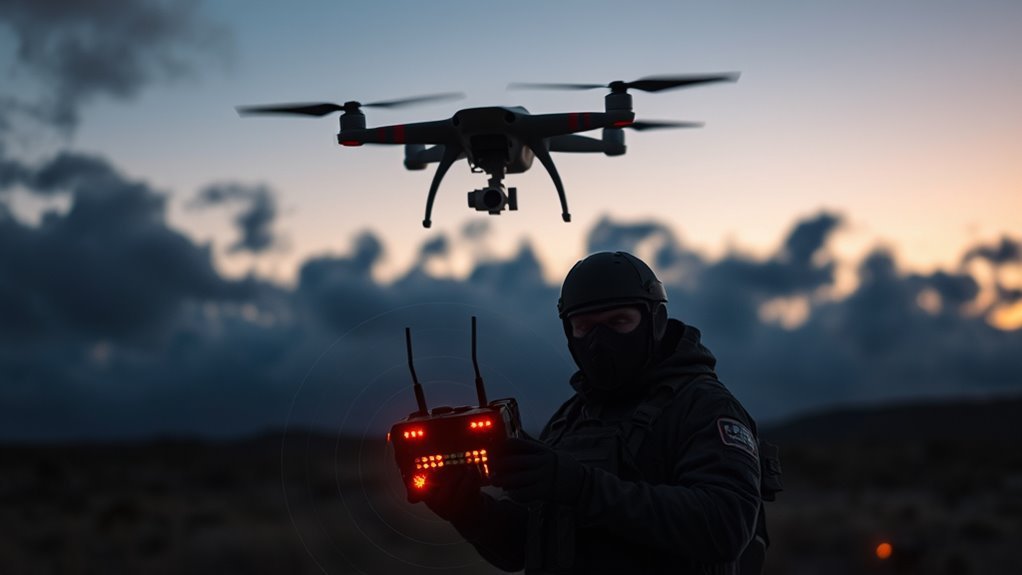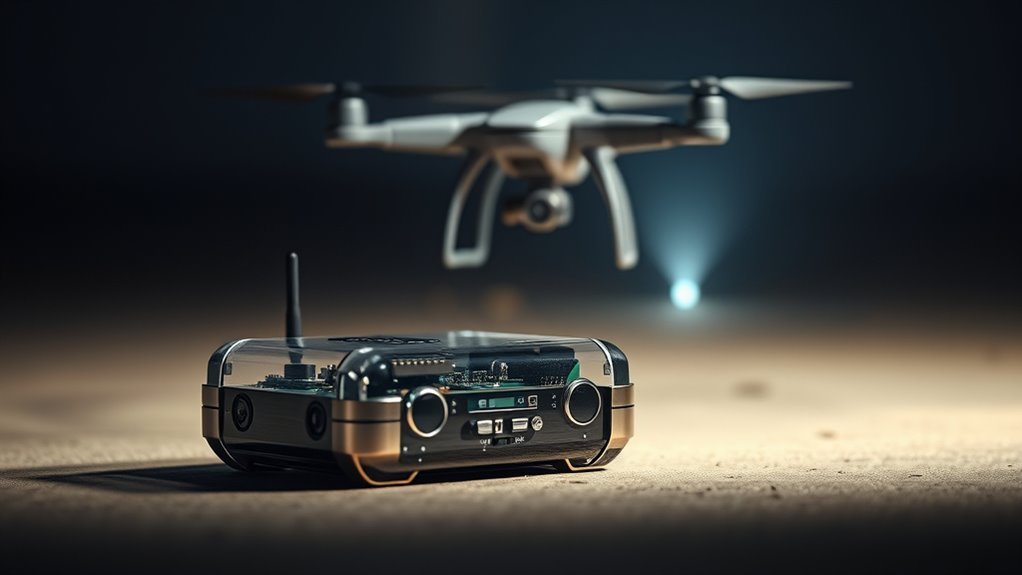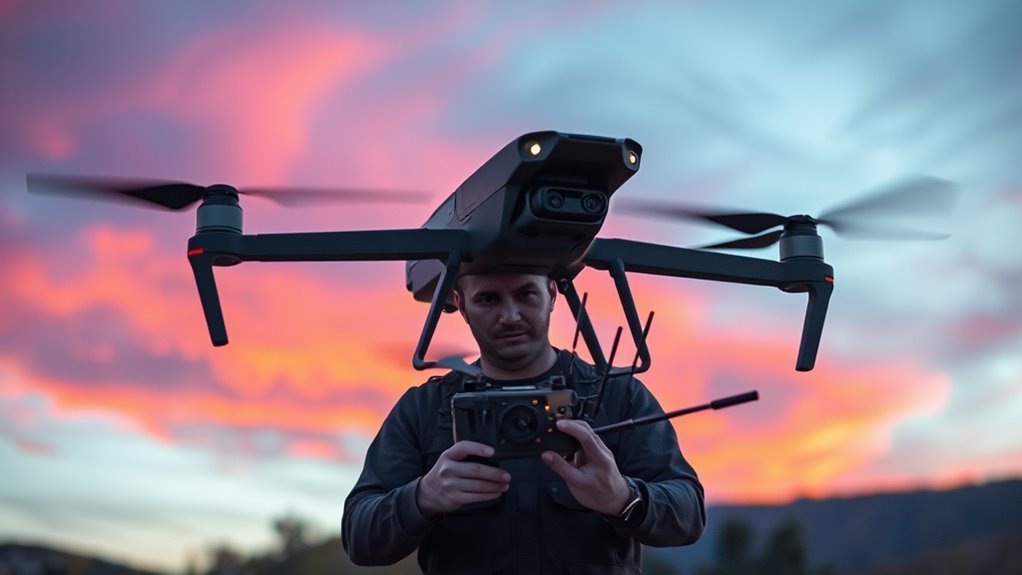To effectively jam a drone, you need to understand its technology and signals. Focus on targeting specific frequencies used for control, telemetry, and video transmission. Employ techniques like frequency jamming or GPS spoofing while considering the legal implications, as unauthorized jamming can lead to severe penalties. Always prioritize safety by evaluating your environment and communicating with your team. There’s much more to explore about the intricate world of drone jamming and its evolving technologies.
Understanding Drone Technology

Drones, or unmanned aerial vehicles (UAVs), rely on a complex integration of hardware and software to operate effectively. Understanding drone components is essential for anyone looking to gain insight into their functionality. Key components include the frame, motors, sensors, and the flight controller, each playing a pivotal role in flight stability and maneuverability. Signal processing is vital for real-time data transmission between the drone and the operator. It involves the interpretation and management of signals from various sensors, ensuring efficient communication and control. By grasping these technical aspects, you can appreciate the intricacies of drone technology and its implications on autonomy, security, and freedom. This knowledge can empower you to navigate and potentially disrupt UAV operations. Additionally, understanding hover precision and stability can enhance your ability to assess drone performance in various conditions. Drones typically operate on common radio frequency bands, which can impact their communication reliability and range.
Types of Drone Signals

Understanding the types of signals used in drone operations is essential for comprehending their communication and control mechanisms. Drones primarily rely on three signal types: control signals, telemetry signals, and video signals. By recognizing these signals, you can effectively implement jamming techniques. The XG Neith Drone’s advanced camera capabilities enhance its video signal quality, making jamming efforts more complex.
| Signal Type | Description | Jamming Technique |
|---|---|---|
| Control Signals | Commands sent from the operator | Frequency jamming |
| Telemetry Signals | Data on drone’s status and location | Spoofing |
| Video Signals | Live feed from the camera | Signal interference |
Legal Considerations for Jamming Drones

While jamming a drone may seem like a straightforward solution to mitigate unwanted surveillance or privacy invasion, it’s vital to understand the legal implications involved. Many countries have strict drone regulations, making it illegal to disrupt drone signals. Engaging in jamming activities can lead to severe jamming penalties, including fines or criminal charges. You must also consider the potential impact on nearby communications, as jamming devices can interfere with necessary services. This not only raises safety concerns but could also subject you to civil liability. Thus, weighing your desire for freedom against the legal risks is critical. Always explore lawful alternatives to protect your privacy without violating laws surrounding drone operation and interference. Furthermore, understanding legal boundaries is crucial to avoid destructive measures.
Jamming Techniques and Devices
Employing jamming techniques to disrupt drone operations requires a solid grasp of the various devices available and how they function. You’ll find several jamming devices designed to create signal interference, effectively disrupting communication between the drone and its operator. These devices can target specific frequencies, leveraging power output and modulation techniques to maximize effectiveness. For instance, handheld jammers are portable and can be used in close proximity, while more sophisticated systems may offer broader coverage. Understanding the operational range and frequency bands of your target drone is essential. By selecting the appropriate jamming device, you can effectively neutralize drone capabilities, ensuring your environment remains free from unwanted surveillance or intrusion.
Signal Interference Methods
To effectively disrupt drone operations, various signal interference methods can be utilized, each tailored to exploit the vulnerabilities of different communication protocols. One primary technique involves generating noise within the frequency bands used by the drone, causing signal degradation. This method can lead to loss of control signals or GPS, effectively rendering the drone unresponsive. Another approach includes employing targeted interference techniques, which focus on specific signal types, disrupting the communication link between the drone and its operator. By understanding the particular communication protocols in use, you can select the most appropriate interference method. Ultimately, mastering these signal interference techniques empowers you to assert control over the airspace and safeguard your freedom from unwanted drone surveillance. Additionally, awareness of frequency band selection can enhance the effectiveness of your jamming efforts, targeting the most vulnerable communication channels used by drones.
GPS Spoofing vs. Traditional Jamming
When considering how to disrupt a drone’s operations, understanding the mechanisms of GPS spoofing is essential. Unlike traditional jamming, which indiscriminately blocks signals, GPS spoofing manipulates the drone’s navigation by sending false location data. This distinction highlights the limitations of traditional jamming in environments where precise control is necessary.
Mechanism of GPS Spoofing
While traditional jamming disrupts GPS signals by overwhelming them with noise, GPS spoofing takes a more deceptive approach by sending false signals that mimic legitimate ones. This method relies on sophisticated GPS signal manipulation, often utilizing spoofing techniques that allow the attacker to control the perceived location of the target device. By broadcasting counterfeit signals at a higher power than the authentic ones, the drone is tricked into believing it’s receiving valid data. This can lead to a complete loss of situational awareness for the drone, allowing you to redirect or disable it without causing physical damage. Understanding these mechanisms is essential for anyone seeking to maintain their freedom from unwanted surveillance or control.
Limitations of Traditional Jamming
Traditional jamming has its own set of limitations that can hinder its effectiveness compared to GPS spoofing. One major challenge is the frequency range; most jammers are restricted to specific bands, making them less versatile against various drone technologies. Additionally, traditional jamming can inadvertently disrupt nearby communications, leading to collateral damage and potential legal issues. Moreover, drones equipped with advanced sensors can quickly identify and counteract jamming signals, diminishing the jamming device’s impact. In contrast, GPS spoofing can manipulate a drone’s navigation without broad-spectrum interference, allowing for more precise control. Understanding these traditional limitations and jamming challenges is essential for anyone seeking effective countermeasures against drones, particularly in scenarios where freedom and safety must be balanced.
Safety Considerations When Jamming Drones
When considering jamming drones, you must understand the legal implications and guarantee compliance with regulations. It’s essential to follow established safety protocols to mitigate risks associated with interference. Neglecting these factors can lead to serious consequences, both legally and regarding safety.
Legal Implications of Jamming
Although jamming a drone might seem like a straightforward solution to mitigate unwanted aerial incursions, the legal implications of such actions are complex and significant. Engaging in jamming can expose you to serious legal consequences, given the existing regulatory frameworks governing drone usage and signal interference.
- Jamming devices are typically illegal without proper authorization.
- Violating FCC regulations can lead to hefty fines and criminal charges.
- Jamming can disrupt critical communications, posing safety risks beyond just the drone.
- Legal defenses for jamming actions are limited and rarely successful.
Before taking any action, you should understand the potential ramifications and explore alternative methods to address your concerns. Ignoring these implications could result in serious legal troubles.
Safety Protocols to Follow
Engaging in jamming activities carries significant risks, not only legally but also regarding safety. To mitigate these risks, you should always wear appropriate safety equipment, including goggles and protective clothing. Prior to any jamming operation, familiarize yourself with emergency procedures. This includes having a first-aid kit accessible and knowing the quickest route to emergency services. Make certain that your jamming device is properly calibrated to avoid unintended interference with nearby communications or emergency signals. Conduct a thorough risk assessment of the area, identifying potential hazards like nearby aircraft or populated zones. Finally, maintain clear communication with any team members, making sure everyone understands their roles and responsibilities during the operation. This structured approach can help guarantee a safer jamming experience.
Alternatives to Jamming Drones
While jamming drones might seem like the most straightforward solution to mitigate their presence, there are several alternatives worth considering. Exploring non jamming solutions can provide effective ways to address the challenges posed by drones without resorting to disruptive methods. Here are some alternative methods you could implement:
- Geofencing: Utilize software that restricts drone operations within specified airspace. This technology can be particularly effective when integrated with advanced navigation algorithms that allow for precise location tracking.
- Detection Systems: Invest in radar or acoustic systems that identify drone activity.
- Physical Barriers: Erect structures that obstruct drone access to sensitive areas.
- Drone Disabling Technologies: Employ net guns or other mechanisms to safely capture drones. Additionally, understanding drone registration requirements ensures that any operational solutions adhere to legal standards.
Case Studies of Successful Drone Jamming
As drone threats have become more prevalent, several case studies highlight the effectiveness of jamming technologies in various scenarios. One notable instance involved a military operation where jamming systems successfully disrupted hostile drones during a reconnaissance mission. By targeting specific frequencies, operators achieved successful operations without collateral damage. In another case, law enforcement utilized jamming to neutralize rogue drones near critical infrastructure, demonstrating effective tactical applications in urban settings. These examples underscore the significance of precise frequency targeting and real-time response capabilities. Through careful analysis, you can see that when deployed strategically, jamming technologies can safeguard crucial areas and guarantee the safety of individuals, reinforcing the critical need for effective countermeasures in an increasingly drone-armed world.
Future of Drone Jamming Technology
With the rapid evolution of drone technology, the future of drone jamming is poised to become increasingly sophisticated and necessary. As emerging technologies develop, you’ll notice several future trends shaping this field:
The future of drone jamming is evolving rapidly, becoming more sophisticated and essential for security.
- Advanced Signal Disruption: Utilizing AI algorithms to predict and counter drone movements.
- Integrated Defense Systems: Combining jamming with other technologies like lasers for multi-layered defense.
- Regulatory Frameworks: Establishing guidelines to balance security needs with civil liberties.
- User-Friendly Interfaces: Simplifying control systems for non-expert operators to effectively manage jamming devices.
These advancements aim to enhance the effectiveness of drone jamming while ensuring you can maintain your freedom and security in a rapidly changing technological landscape. Understanding these trends will be essential as you navigate the complexities of drone jamming in the future.
Frequently Asked Questions
What Are the Risks of Jamming Drones in Public Areas?
Jamming drones in public areas poses significant risks, including potential threats to public safety and legal consequences. You could face charges for interfering with air traffic, compromising emergency services, or violating federal regulations.
Can Jamming Devices Be Legally Purchased for Personal Use?
In your quest for personal safety, you must consider the legal implications of acquiring jamming devices. While some may argue for freedom, it’s essential to understand that legality varies greatly by jurisdiction, complicating personal use.
How Can I Identify a Drone Before Jamming It?
To identify a drone, use drone identification techniques like visual recognition methods. Observe its size, shape, flight pattern, and any distinct markings. These details’ll help you differentiate it from other aerial objects before taking action.
What Are the Technical Limitations of Drone Jamming?
Ever wondered why jamming a drone isn’t foolproof? Signal interference can be effective, but range limitations can restrict your ability to disrupt signals, making it essential to understand these factors for successful drone countermeasures.
Are There Specific Frequencies I Should Target for Jamming?
You should target specific frequency ranges typically used by drones, like 2.4 GHz and 5.8 GHz. Employing effective jamming protocols guarantees disruption, but be aware of legal implications and unintended interference with other devices.

